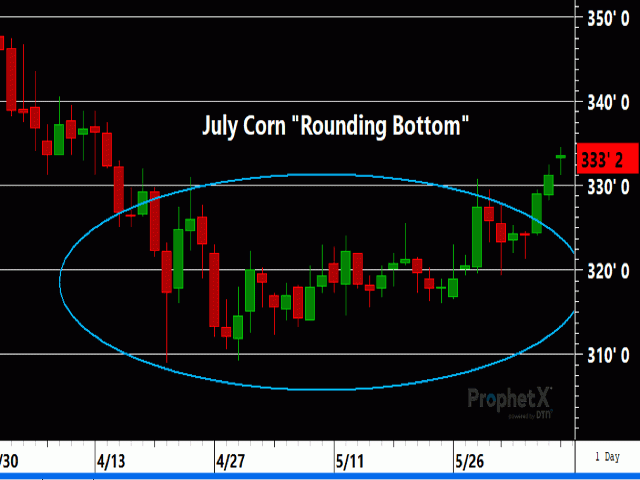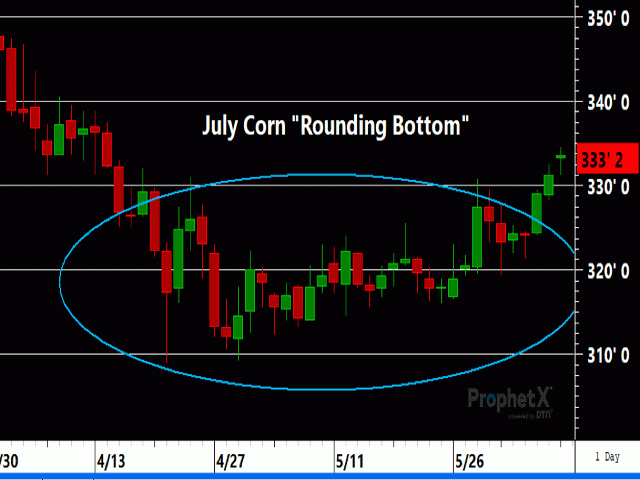Technically Speaking
Grain Market Uptrends Intact
July Corn:
For this analysis we will be looking at both the July corn contract as well as the active-continuation chart of corn futures. Both contracts have turned in an impressive performance since making lows in late April. The July corn contract looks increasingly likely that the lows made at $3.09 on April 21 marked the end of a complete five-wave Elliot sequence. Confidence can be had in this call because of the impulsive, trendy behavior exhibited in the way down from January highs near 4.04 1/2 as well as the bullish divergence in momentum from the April lows as the contract takes out former corrective highs. The question now becomes where the contract goes from here. It is far too early to tell whether the current rally is the beginning of a major counter-trend higher, or whether we are staring at a corrective rally ahead of a new round of lows below $3.09. What is crucial at this juncture is to determine the scale at which we are measuring this market. From a shorter-term, daily scale, we would expect the current uptrend to continue to at least the 38.2% retracement of the $3.94 (continuous chart) high on Jan. 23 to the $3.09 low on April 21 around $3.41 1/2. Whether the contract heads directly there, or makes a B-wave correction matters little, but should still achieve that target as part of this pattern. From a longer-term scale looking all the way back to the July 2019 highs at $4.64 3/4, the current rally looks rather small in terms of scale. It is also evident there is little in the way of resistance between spot levels and March highs around $3.86 3/4 in terms of actual price resistance.
P[L1] D[0x0] M[300x250] OOP[F] ADUNIT[] T[]
July Soybeans:
Soybeans have enjoyed their own rally of late, although not as impressive in percentage terms as the corn market. Nonetheless, July soybeans have some interesting technical considerations to be aware of. For starters, it looks like July soybeans are currently working on an inverted head-and-shoulders pattern with the head recently completed and the current rally working toward the neckline around $8.90. If this pattern were to hold true, we would expect the current rally effort to continue to the $8.80 to $8.95 area before a setback would be seen to complete the right shoulder. A sell-off for the right shoulder would likely take price back down to the $8.40 to $8.50 area. One caveat with this call, however, is the fact the July contract most likely doesn't have enough time to complete this pattern before it goes into delivery and expires. When flipping to the active-continuation chart, the pattern is much less apparent and arguably not there. On the continuation chart, the left shoulder is lower in price than the head, something which should invalidate the pattern. That said, we still like the July contract continuing its rally to the $8.80 to $8.90 level before an interim correction.
July Chicago Wheat:
Wheat markets have also been trending higher of late, although in much more choppy fashion than row crops. Oddly enough, July Chicago wheat also has an inverted head-and-shoulders pattern with current price action tracing out the right shoulder ahead of what would be expected to be the test of the neckline. The most encouraging technical factor in Chicago wheat is the fact the May lows were a retest of the March lows but the lows held. Seasonally, lows are typically made sometime between May and June, lining up nicely with this season's trade just below $5.00. We would expect those March and May lows to hold on any retest effort, but until then, the trendy behavior is encouraging. Several corrective lows exist that will act as triggers to reduce bullish exposure on setback attempts. The first would be the $5.06 1/2 corrective low from June 3.
Tregg Cronin can be reached at tmcronin31@gmail.com
Follow Tregg Cronin on Twitter @5thWave_tcronin
Comments above are for educational purposes and are not meant to be specific trade recommendations. The buying and selling of grains and grain futures involve substantial risk and are not suitable for everyone.
© (c) Copyright 2020 DTN, LLC. All rights reserved.





Comments
To comment, please Log In or Join our Community .